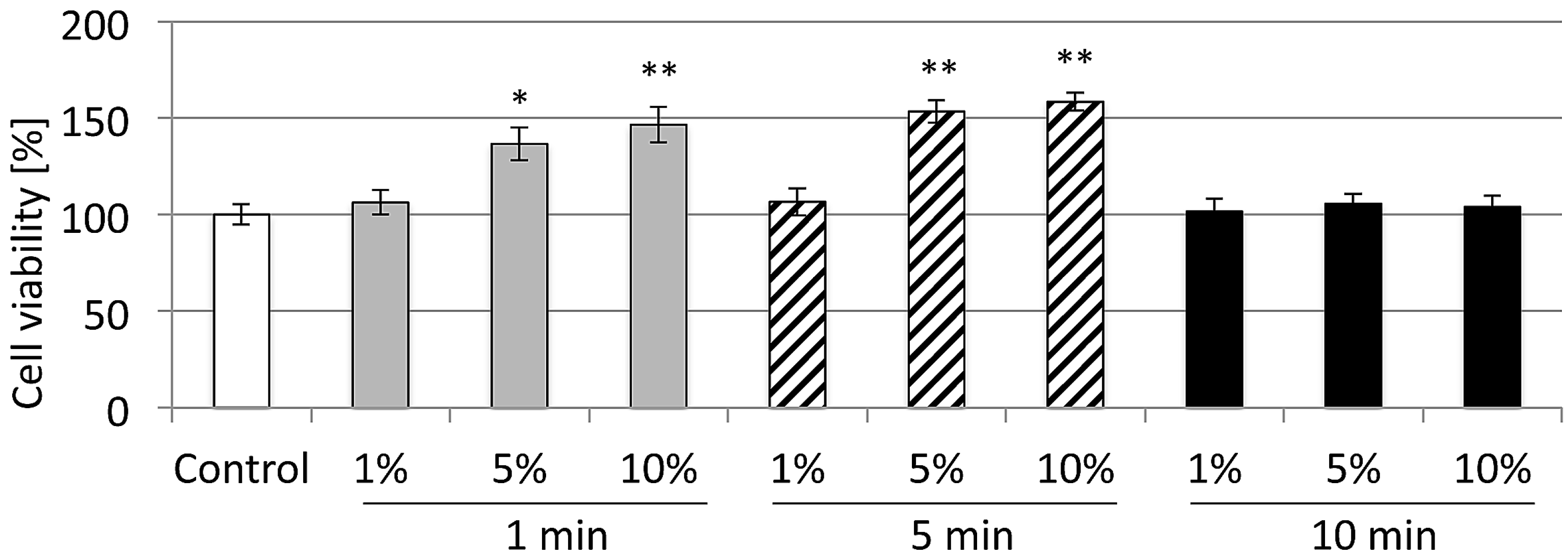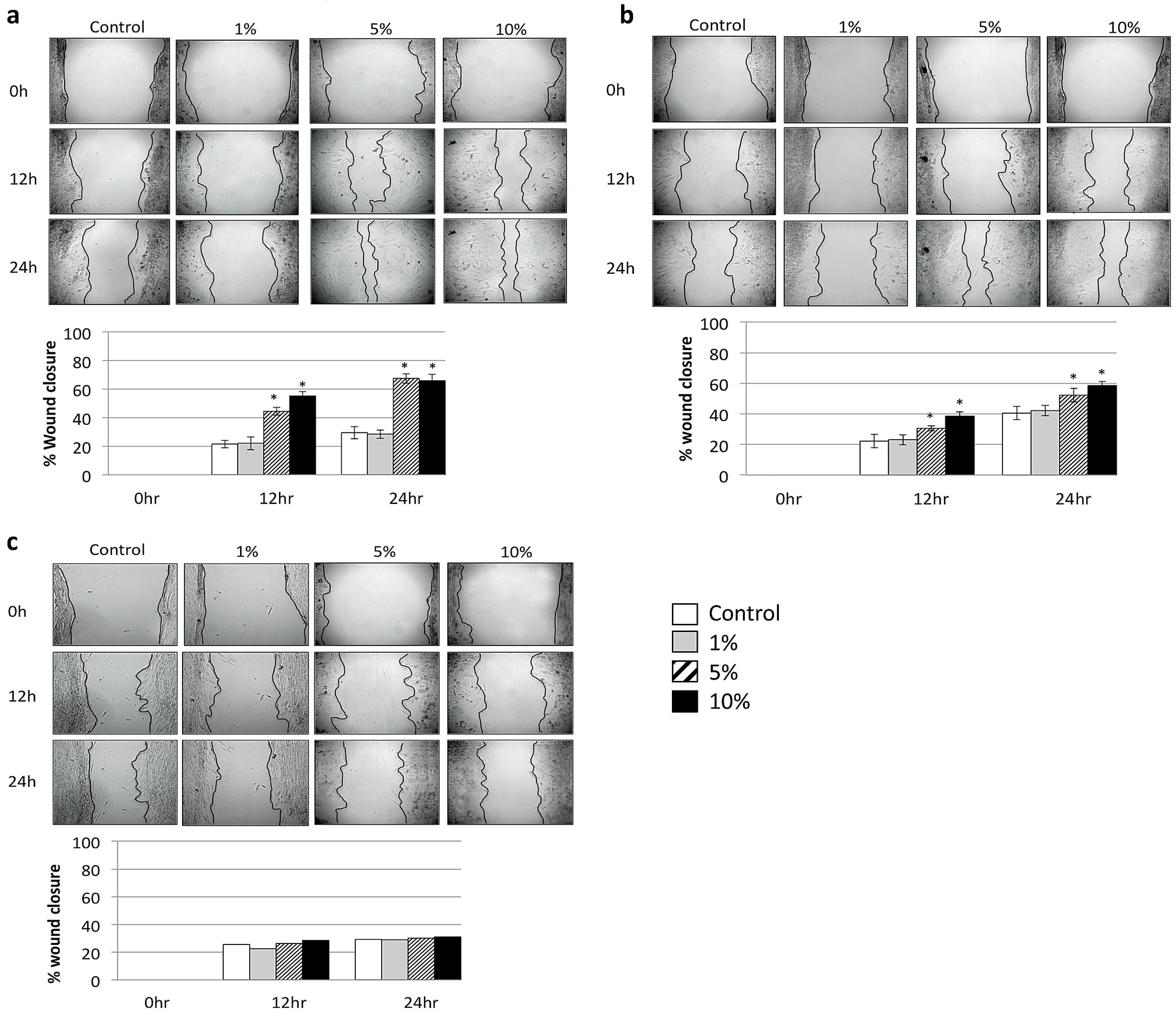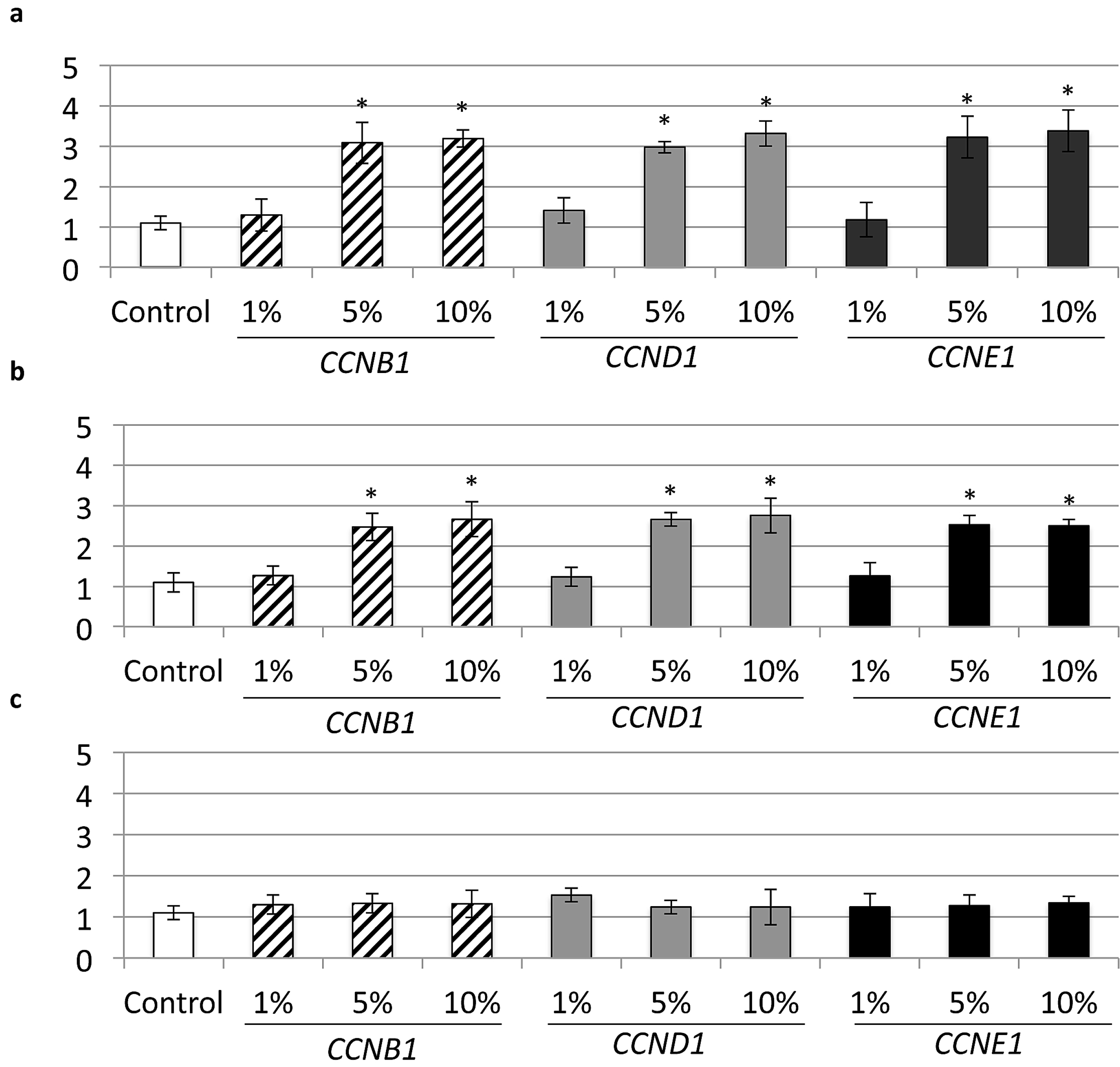Cerium Chloride Application Promotes Wound Healing and Cell Proliferation in Human Foreskin Fibroblasts
Abstract
:1. Introduction
2. Results
2.1. Cell Viability
2.2. Scratch-Wound Healing Assay
2.3. Gene Expression Assay
3. Discussion
4. Materials and Methods
4.1. Cerium Solutions
4.2. Cell Culture
4.3. Cell Viability
4.4. Scratch-Wound Assay (Cell Migration)
4.5. Real-Time RT-PCR Analysis
4.6. Statistical Analysis
5. Conclusions
- -
- Cell viability of HFF was significantly enhanced after 1 and 5 min applications of 5% and 10% CeCl3 compared to the cells cultured without CeCl3 (p < 0.05 at 72 h), whereas no cell activity was found for an exposure time longer than 10 min.
- -
- Cells exposed to cerium at concentrations of 5% and 10% showed an increase in cell migration up to 60% at 1 and 5 min of CeCl3 exposure on the scratch-wound healing assay at 24 h. Consequently, wound closure was almost complete after 24 h in the presence of cerium, whereas this effect was far from being complete in the control samples.
- -
- qPCR analysis showed the upregulation of CCNB1, CCND1 and CCNE1 in same concentrations of 5% and 10%, which confirmed the increase in the cell proliferation rate. This could facilitate wound healing and the cell migration process. A time-dependent increase of CCNB1, CCND1 and CCNE1 expression was evident on all cell cultures at 72 h after exposure to cerium.
Acknowledgments
Author Contributions
Conflicts of Interest
Abbreviations
| CeCl3 | cerium chloride |
| HFF | human foreskin fibroblasts |
References
- Jakupec, M.A.; Unfried, P.; Keppler, B.K. Pharmacological properties of cerium compounds. Rev. Physiol. Biochem. Pharmacol. 2005, 153, 101–111. [Google Scholar] [CrossRef] [PubMed]
- Monafo, W.W.; Tandon, S.N.; Ayvazian, V.H.; Tuchschmidt, J.; Skinner, A.M.; Deitz, F. Cerium nitrate: A new topical antiseptic for extensive burns. Surgery 1976, 80, 465–473. [Google Scholar] [PubMed]
- Kostova, I. Synthetic and natural coumarins as cytotoxic agents. Curr. Med. Chem. Anticancer Agents 2005, 5, 29–46. [Google Scholar] [CrossRef] [PubMed]
- Lansdown, A.B.; Myers, S.R.; Clarke, J.A.; O’Sullivan, P. A reappraisal of the role of cerium in burn wound management. J. Wound Care 2003, 12, 113–118. [Google Scholar] [CrossRef] [PubMed]
- Regulati, B.; Schait, A.; Schmid, R.; Mŭhlemann, H.R.; Regolati, B.; Schait, A.; Schmid, R.; Mühlemann, H.R. Effect of enamel solubility reducing agents on erosion in the rat. Helv. Odontol. Acta 1975, 19, 31–36. [Google Scholar] [PubMed]
- Zhang, W.; Jin, H.; Liu, A. A comparison of the preventive effects of lanthanides and fluoride on human experimental root surface carious-like lesions. Chin. J. Dent. Res. 1999, 2, 38–44. [Google Scholar] [PubMed]
- Wegehaupt, F.J.; Sener, B.; Attin, T.; Schmidlin, P.R. Application of cerium chloride to improve the acid resistance of dentine. Arch. Oral Biol. 2010, 55, 441–446. [Google Scholar] [CrossRef] [PubMed]
- Wegehaupt, F.J.; Sener, B.; Attin, T.; Schmidlin, P.R. Anti-erosive potential of amine fluoride, cerium chloride and laser irradiation application on dentine. Arch. Oral Biol. 2011, 56, 1541–1547. [Google Scholar] [CrossRef] [PubMed]
- Drynda, A.; Deinet, N.; Braun, N.; Peuster, M. Rare earth metals used in biodegradable magnesium-based stents do not interfere with proliferation of smooth muscle cells but do induce the upregulation of inflammatory genes. J. Biomed. Mater. Res. A 2009, 91, 360–369. [Google Scholar] [CrossRef] [PubMed]
- Haley, P.J. Pulmonary toxicity of stable and radioactive lanthanides. Health Phys. 1991, 61, 809–820. [Google Scholar] [CrossRef] [PubMed]
- Kuruvilla, L.; Kartha, C.C. Cerium depresses endocardial endothelial cell-mediated proliferation of cardiac fibroblasts. Biol. Trace Elem. Res. 2006, 114, 85–92. [Google Scholar] [CrossRef]
- Zhang, J.; Liu, C.; Li, Y.; Sun, J.; Wang, P.; Di, K.; Zhao, Y. Effect of cerium ion on the proliferation, differentiation and mineralization function of primary mouth osteoblasts in vitro. J. Rare Earths 2010, 28, 138–142. [Google Scholar] [CrossRef]
- Nair, R.R.; Preeta, R.; Smitha, G.; Adiga, I. Variation in mitogenic response of cardiac and pulmonary fibroblasts to cerium. Biol. Trace Elem. Res. 2003, 94, 237–246. [Google Scholar] [CrossRef]
- Martin, P. Wound healing-aiming for perfect skin regeneration. Science 1997, 276, 75–81. [Google Scholar] [CrossRef] [PubMed]
- Schmidlin, P.R.; Tchouboukov, A.; Wegehaupt, F.J.; Weber, F.E. Effect of cerium chloride application on fibroblast and osteoblast proliferation and differentiation. Arch. Oral Biol. 2012, 57, 892–897. [Google Scholar] [CrossRef] [PubMed]
- Schmidlin, P.R.; Imfeld, T.; Sahrmann, P.; Tchouboukov, A.; Weber, F.E. Effect of short-time povidone-iodine application on osteoblast proliferation and differentiation. Open Dent. J. 2009, 3, 208–212. [Google Scholar] [CrossRef] [PubMed]
- Preeta, R.; Nair, R.R. Stimulation of cardiac fibroblast proliferation by cerium: A superoxide anion-mediated response. J. Mol. Cell. Cardiol. 1999, 31, 573–580. [Google Scholar] [CrossRef] [PubMed]
- Feyerabend, F.; Fischer, J.; Holtz, J.; Witte, F.; Willumeit, R.; Drücker, H.; Vogt, C.; Hort, N. Evaluation of short-term effects of rare earth and other elements used in magnesium alloys on primary cells and cell lines. Acta Biomater. 2010, 6, 1834–1842. [Google Scholar] [CrossRef] [PubMed]
- Hochegger, H.; Takeda, S.; Hunt, T. Cyclin-dependent kinases and cell-cycle transitions: Does one fit all? Nat. Rev. Mol. Cell Biol. 2008, 9, 910–916. [Google Scholar] [CrossRef] [PubMed]
- Ayala, P.; Lopez, J.I.; Desai, T.A. Microtopographical cues in 3D attenuate fibrotic phenotype and extracellular matrix deposition: Implications for tissue regeneration. Tissue Eng. Part A 2010, 16, 2519–2527. [Google Scholar] [CrossRef] [PubMed]
- Boateng, S.Y.; Hartman, T.J.; Ahluwalia, N.; Vidula, H.; Desai, T.A.; Russell, B. Inhibition of fibroblast proliferation in cardiac myocyte cultures by surface microtopography. Am. J. Physiol. Cell Physiol. 2003, 285, C171–C182. [Google Scholar] [CrossRef] [PubMed]
- Yoon, B.S.; Moon, J.H.; Jun, E.K.; Kim, J.; Maeng, I.; Kim, J.S.; Lee, J.H.; Baik, C.S.; Kim, A.; Cho, K.S.; et al. Secretory profiles and wound healing effects of human amniotic fluid-derived mesenchymal stem cells. Stem Cells Dev. 2010, 19, 887–902. [Google Scholar] [CrossRef] [PubMed]
- Nowinski, D.; Lysheden, A.S.; Gardner, H.; Rubin, K.; Gerdin, B.; Ivarsson, M. Analysis of gene expression in fibroblasts in response to keratinocyte-derived factors in vitro: Potential implications for the wound healing process. J. Investig. Dermatol. 2004, 22, 216–221. [Google Scholar] [CrossRef]
- Dai, Y.; Li, J.; Li, J.; Yu, L.; Dai, G.; Hu, A.; Yuan, L.; Wen, Z. Effects of rare earth compounds on growth and apoptosis of leukemic cell lines. In Vitro Cell. Dev. Biol. Anim. 2002, 38, 373–375. [Google Scholar] [CrossRef]
- Barrientos, S.; Stojadinovic, O.; Golinko, M.S.; Brem, H.; Tomic-Canic, M. Growth factors and cytokines in wound healing. Wound Repair Regen. 2008, 16, 585–601. [Google Scholar] [CrossRef] [PubMed]
- Chigurupati, S.; Mughal, M.R.; Okun, E.; Das, S.; Kumar, A.; McCaffery, M.; Seal, S.; Mattson, M.P. Effects of cerium oxide nanoparticles on the growth of keratinocytes, fibroblasts and vascular endothelial cells in cutaneous wound healing. Biomaterials 2013, 34, 2194–2201. [Google Scholar] [CrossRef] [PubMed]
- Alili, L.; Sack, M.; von Montfort, C.; Giri, S.; Das, S.; Carroll, K.S.; Zanger, K.; Seal, S.; Brenneisen, P. Downregulation of tumor growth and invasion by redox-active nanoparticles. Antioxid. Redox Signal. 2013, 19, 765–778. [Google Scholar] [CrossRef] [PubMed]
- Kumar, B.P.; D’Souza, S.L.; Shivakumar, K.; Rathinam, K. Cerium stimulates protein biosynthesis in rat heart in vivo. Biol Trace Elem Res. 1995, 50, 237–242. [Google Scholar] [CrossRef] [PubMed]
- Benameur, L.; Auffan, M.; Cassien, M.; Liu, W.; Culcasi, M.; Rahmouni, H.; Stocker, P.; Tassistro, V.; Bottero, J.Y.; Rose, J.; et al. DNA damage and oxidative stress induced by CeO2 nanoparticles in human dermal fibroblasts: Evidence of a clastogenic effect as a mechanism of genotoxicity. Nanotoxicology 2015, 9, 696–705. [Google Scholar] [CrossRef] [PubMed]
- Culcasi, M.; Benameur, L.; Mercier, A.; Lucchesi, C.; Rahmouni, H.; Asteian, A.; Casano, G.; Botta, A.; Kovacic, H.; Pietri, S. EPR spin trapping evaluation of ROS production in human fibroblasts exposed to cerium oxide nanoparticles: Evidence for NADPH oxidase and mitochondrial stimulation. Chem. Biol. Interact. 2012, 199, 161–176. [Google Scholar] [CrossRef] [PubMed]



| Gene | Primer Pair Sequence |
|---|---|
| CCNE1 | (forward) 5′-GAAATGGCCAAAATCGACAG-3′ (reverse) 5′-TCTTTGTCAGGTGTGGGGA-3′ |
| CCND1 | (forward) 5′-ACAAACAGATCATCCGCAAACAC -3′ (reverse) 5′-TGTTGGGGCTCCTCAGGTTC-3′ |
| CCNB1 | (forward) 5′-GGGTGTGCTTTGAATTCTGACA-3′ (reverse) 5′-AGGAGTGGCGCCTTGGTAT-3′ |
| GAPDH | (forward) 5′-GCTCTCTGCTCCTCCCTGTT-3′ (reverse) 5′-CACACCGACCTTCACCATCT-3′ |
© 2017 by the authors. Licensee MDPI, Basel, Switzerland. This article is an open access article distributed under the terms and conditions of the Creative Commons Attribution (CC BY) license (http://creativecommons.org/licenses/by/4.0/).
Share and Cite
Ramenzoni, L.L.; Weber, F.E.; Attin, T.; Schmidlin, P.R. Cerium Chloride Application Promotes Wound Healing and Cell Proliferation in Human Foreskin Fibroblasts. Materials 2017, 10, 573. https://doi.org/10.3390/ma10060573
Ramenzoni LL, Weber FE, Attin T, Schmidlin PR. Cerium Chloride Application Promotes Wound Healing and Cell Proliferation in Human Foreskin Fibroblasts. Materials. 2017; 10(6):573. https://doi.org/10.3390/ma10060573
Chicago/Turabian StyleRamenzoni, Liza L., Franz E. Weber, Thomas Attin, and Patrick R. Schmidlin. 2017. "Cerium Chloride Application Promotes Wound Healing and Cell Proliferation in Human Foreskin Fibroblasts" Materials 10, no. 6: 573. https://doi.org/10.3390/ma10060573







